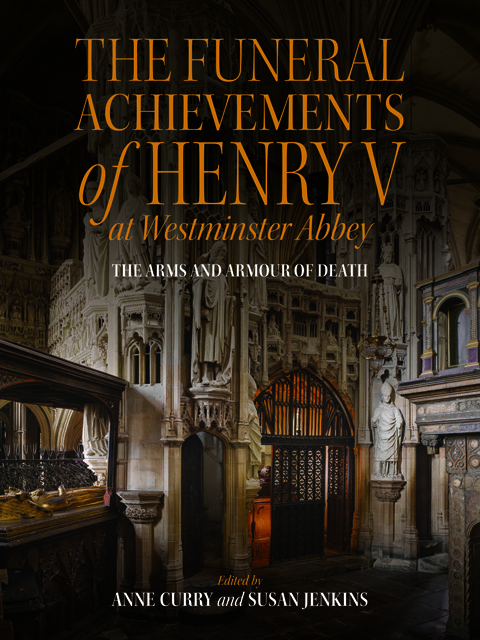Book contents
- Frontmatter
- Dedication
- Contents
- List of Illustrations
- List of Contributors
- Foreword
- Preface
- Acknowledgements
- List of Abbreviations
- 1 Introduction: Henry V and Westminster Abbey – Life, Death and Afterlife
- 2 Henry V’s Funeral Achievements in the Context of Westminster Abbey : ‘Trophies of this Warlike Prince’
- 3 The Funeral of Henry V
- 4 Henry V’s Chapel
- 5 The Funerary Helm of King Henry V : A Helm for the Joust of Peace, c. 1380–1420
- 6 A Saddle from the Funeral of Henry V
- 7 The Shield from the Funeral Achievements of Henry V
- 8 ‘Our bruisèd arms hung up for monuments’. The Sword of Henry V?
- 9 Conservation of the Funeral Achievements
- 10 Scientific Analysis: Micro-Invasive Techniques
- 11 Scientific Analysis: Non-Invasive Techniques
- Appendix: The Will of Henry V, 1421
- Index of People and Places
- Royal Armouries Research Series
8 - ‘Our bruisèd arms hung up for monuments’. The Sword of Henry V?
Published online by Cambridge University Press: 11 January 2023
- Frontmatter
- Dedication
- Contents
- List of Illustrations
- List of Contributors
- Foreword
- Preface
- Acknowledgements
- List of Abbreviations
- 1 Introduction: Henry V and Westminster Abbey – Life, Death and Afterlife
- 2 Henry V’s Funeral Achievements in the Context of Westminster Abbey : ‘Trophies of this Warlike Prince’
- 3 The Funeral of Henry V
- 4 Henry V’s Chapel
- 5 The Funerary Helm of King Henry V : A Helm for the Joust of Peace, c. 1380–1420
- 6 A Saddle from the Funeral of Henry V
- 7 The Shield from the Funeral Achievements of Henry V
- 8 ‘Our bruisèd arms hung up for monuments’. The Sword of Henry V?
- 9 Conservation of the Funeral Achievements
- 10 Scientific Analysis: Micro-Invasive Techniques
- 11 Scientific Analysis: Non-Invasive Techniques
- Appendix: The Will of Henry V, 1421
- Index of People and Places
- Royal Armouries Research Series
Summary
Of the four objects suggested as belonging to Henry V’s surviving funerary achievements, the sword is the most problematic. It only became associated with Henry V during the twentieth century, and its dating has never been secure. There can be no doubt that a sword formed part of the funeral rites of Henry in 1422, but the question remains as to whether the sword considered here that has been, and is still, associated with Henry, is that same sword. This chapter attempts to answer this question by placing the sword in its historical context and exploring whether or not it could have been used at the funeral of Henry V. Although this is not the first time the argument has been presented, we offer here a more exhaustive compilation and analysis of the evidence. Various discussions have stated, almost as a passing comment, that the sword does not appear until a particular date, although such dates vary. Yet no previously published account has provided a thorough analysis of the sources that the sword could, should or might have appeared in. Confirming the history of its ‘lack of presence’ in such sources is crucially important for the telling of the sword’s story.
Those not yet ‘abed’ will also have picked up the fact that the title of this paper derives from Shakespeare’s Richard III (Act I, Sc. I, line 7). To the present author, this quotation seems more relevant than the more obvious line from Henry V (‘His bruised helmet and his bended sword’, Act 5, Prologue, line 18) since the sword under consideration was and is not ‘bended’. As this chapter will show, the play from which the title quotation was chosen turned out to be even more apposite than was initially suspected.
To the present author when younger, Henry V was a medieval fighting ‘Action Man’ hero who ought indubitably to have a sword, like all great medieval heroes, such as El Cid, Wallace and Bruce. He was a national hero, and the will to believe in relics of this warrior king was strong, particularly in something as ‘iconic’ as his sword.
- Type
- Chapter
- Information
- The Funeral Achievements of Henry V at Westminster AbbeyThe Arms and Armour of Death, pp. 157 - 191Publisher: Boydell & BrewerPrint publication year: 2022



